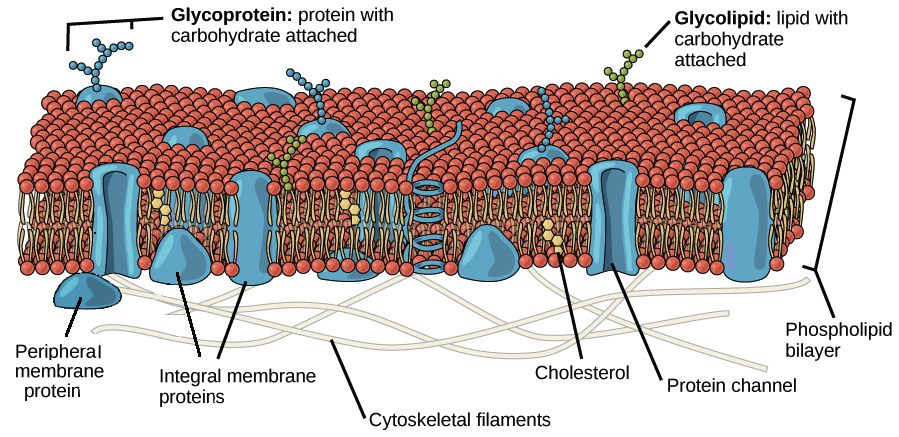Describe the Composition of the Plasma Membrane.
This layer is semipermeable and is responsible for the regulation and transportation of materials. Structure of the plasma membrane as a mosaic of components including phospholipids cholesterol proteins and carbohydratesthat gives the membrane a fluid character.

How To Describe The Molecular Structure Of The Plasma Membrane Quora
Depicts the plasma membrane as exceedingly thin 7-10nm flexible structure composed of a double layer or bilayer of lipid molecules with protein molecules plugged into it.

. There are various proteins embedded within the membrane that have a variety of functions. Cholesterol is also present between the phospholipids which contributes to the fluidity of the membrane. Describe the composition of the plasma membrane.
Components of plasma membranes are. It is also simply called the cell membrane. The Plasma Membrane is mainly composed of a layer of lipid molecules.
The fluid mosaic model of the plasma membrane. It also needs proteins which are involved in cross-membrane transport and cell communication and carbohydrates sugars and sugar chains which decorate both the proteins and lipids and help cells recognize each other. This is the currently selected item.
Answer 1 of 2. They have both a hydrophobic end and a hydrophillic end. It is semi-permeable and regulates the materials that enter and.
The plasma membrane of a cell is a network of lipids and proteins that forms the boundary between a cells contents and the outside of the cell. Describe the structure of the plasma membranecell membrane-Basic structure according to fluid mosaic model. This membrane is composed of two layers of lipid or fat molecules phospholipids in particular with the water-repelling tails of these molecules directed toward the middle of the membrane and.
In this article we will discuss about the chemical composition and functions of plasma membrane. The chemical composition of two plasma membrane fractions from epimastigote forms of Trypanosoma cruzi is reported. 4Compare and contrast different processes of membrane transport with respect to type of material transported mechanism of transport and.
Robertson 1959 proposed that plasma membrane is three-layered structure where proteins form the outer and. Fraction M a preparation obtained by conventional methods of cell fractionation is composed of 31 proteins 34 lipids 16 carbohydrates and 3 of the lipopeptidophosphoglycan. Describe the composition of the plasma membrane.
List and describe 6 functions performed by proteins found in the plasma membrane. It helps the plasma membrane to retain the fluidity and prevents the compaction of hydrophilic tails at low temperatures and their expansion at high temperatures. The molecular structure of the plasma membrane can be visualized as a sea of phospholipids in which different kinds of proteins are immersed.
These components give a fluid character to the membranes. Phospholipids are amphipathic molecules ie. The membrane is mainly composed of lipids proteins and carbohydrates.
Water makes about 29 of total weight. List and describe 6 functions performed by proteins found in the plasma membrane. A phospholipid is a molecule consisting of glycerol two fatty acids and a phosphate-linked head group.
Plasma membrane is a phospholipid bilayer which consists of polar head facing outward and hydrophobic tail facing inward. 3Describe the function and structure of the glycocalyx. The Plasma Membrane formerly known as the cell membrane forms the border of a neuron and acts to control the movement of substances into and out of the cell.
Also the movement of molecules both large and small in and out. The proteins float in the lipid bilayer forming a changing mosaic pattern. Protein and phospholipid components combine to make a large membrane.
Proteins are embedded within the membranes phospholipid bilayer and are free to move around fluidly have space for diffusion. Why is the plasma membrane described as semi-permeable and find homework help. Give examples to support your answer.
A plasma membranes principal components are lipids phospholipids and cholesterol proteins and carbohydrates attached to some of the lipids and proteins. The proportions of proteins lipids and carbohydrates in the plasma membrane vary with cell type. Phospholipid is composed of.
The main function of the plasma membrane is to protect the cell from its surrounding environment. Structure of the plasma membrane. -Selectively permeable double membrane barrier containing pores-Encloses jellylike nucleoplasm which contains essential solutes-outer membrane is continuous with the rough ER and is studded with ribosomes-Inner membrane is lined with the nuclear lamina which.
Plasma membranes range from 5 to 10 nm in thickness. 2Describe how lipids and proteins are distributed in the plasma membrane and explain the functions of each. It is very thin about 7 to 10 nm and is composed of a bilayer of lipid molecules with proteins dispersed in it.
To perform these roles the plasma membrane needs lipids which make a semi-permeable barrier between the cell and its environment. Cholesterol It is located between the phospholipids and phospholipid bilayers. Protein lipid and carbohydrate components of the membrane.
Chemical Composition of Plasma Membrane. The plasma membrane is an extremely pliable structure composed of 2 layers of back-to-back phospholipids a bilayer. Describe the function of Plasma Membrane.
Median response time is 34 minutes for paid subscribers and may be longer for promotional offers. The plasma membrane is the outer limiting membrane of a cell that separates the bodys two major fluid components the intercellular fluid that is within cells and the extracellular fluid outside of cells. Get an answer for Describe the structure of the plasma cell membrane.

Plasma Membrane Definition Structure Functions Biology Dictionary


Comments
Post a Comment